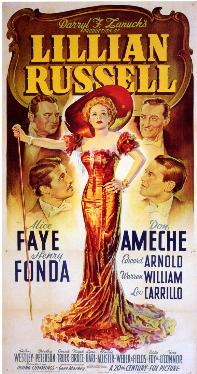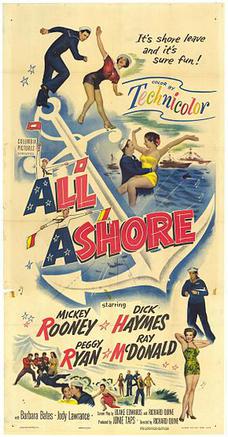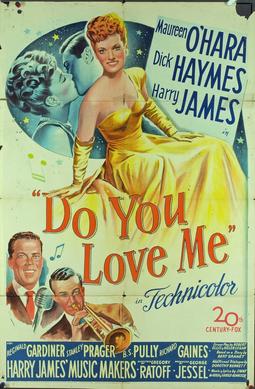This is a list of notable events in music that took place in the year 1945.

Elizabeth Ruth Grable was an American actress, pin-up girl, dancer, model and singer.

Richard Benjamin Haymes was an Argentine singer, songwriter and actor. He was one of the most popular male vocalists of the 1940s and early 1950s. He was the older brother of Bob Haymes, an actor, television host, and songwriter.

The Gang's All Here is a 1943 American Twentieth Century Fox Technicolor musical film starring Alice Faye, Carmen Miranda and James Ellison. The film, directed and choreographed by Busby Berkeley, is known for its use of musical numbers with fruit hats. Included among the 10 highest-grossing films of that year, it was at that time Fox's most expensive production.
Beatrice Kay was an American singer, vaudevillian, music hall performer, and stage and film actress.

Hoop-La is a 1933 American pre-Code drama film directed by Frank Lloyd, and starring Clara Bow, Preston Foster, Richard Cromwell and Minna Gombell also in the cast. The film is based on the play The Barker by Kenyon Nicholson, which was also filmed in 1928 under the same title as the play.
"The More I See You" is a popular song composed by Harry Warren, with lyrics by Mack Gordon. The song was first published in 1945.

The National Midget Auto Racing Hall of Fame is an American Hall of Fame and museum for midget cars. The Hall of Fame is located at Angell Park Speedway in Sun Prairie, Wisconsin, and can be accessed during weekly Sunday races during the summer. Inductees are often honored with their award in January at the Chili Bowl at Tulsa.

It's in the Bag! is a 1945 comedy film featuring Fred Allen in his only starring film role. The film was released by United Artists at a time when Allen was at the peak of his fame as one of the most popular radio comedians. The film has been preserved by UCLA Film & Television Archive. The film is loosely based on the comic novel The Twelve Chairs (1928) of Ilf and Petrov, later filmed by Mel Brooks as The Twelve Chairs (1970). The team of screenwriters included Jay Dratler, Alma Reville, and Morrie Ryskind. Allen's encounter with Jack Benny in the film is notable as at this time they were involved in a famous 'feud', which ran for over a decade.

Lillian Russell is a 1940 American biographical film of the life of the singer and actress. The screenplay was by William Anthony McGuire. The film was directed by Irving Cummings and produced by Darryl F. Zanuck. It stars Alice Faye in the title role, Don Ameche, Henry Fonda and Edward Arnold as Diamond Jim Brady.

Week-End in Havana is a 1941 20th Century Fox Technicolor musical film directed by Walter Lang and starring Alice Faye and Carmen Miranda. It was the second of three pictures the two stars made together and the second Faye film to have a Latin-American theme, typical of Fox musicals of the early 1940s. Faye was pregnant during filming.

The Shocking Miss Pilgrim is a 1947 American musical comedy film in Technicolor written and directed by George Seaton and starring Betty Grable and Dick Haymes.

Four Jills in a Jeep is a 1944 American comedy-drama musical film starring Kay Francis, Carole Landis, Martha Raye and Mitzi Mayfair as themselves, reenacting their USO tour of Europe and North Africa during World War II.

All Ashore is a 1953 American comedy musical film directed by Richard Quine and starring Mickey Rooney, Dick Haymes, Peggy Ryan and Ray McDonald.
Mack Gray was an American actor who was the brother of Joe Gray (actor) and great-uncle of Jon Abrahams.

Oh, You Beautiful Doll is a 1949 American musical film directed by John M. Stahl, starring the musical queen June Haver and Mark Stevens. Co-stars included S.Z. Sakall, Charlotte Greenwood, and Gale Robbins.

Do You Love Me is a 1946 American Technicolor musical romance film directed by Gregory Ratoff and starring Maureen O'Hara, Dick Haymes and Reginald Gardiner. The film also features band leader Harry James and his Orchestra. It was produced and distributed by 20th Century-Fox. Betty Grable makes a cameo at the end of the film. At the time Harry James was married to contracted Fox star Betty Grable.

Melody for Two is a 1937 American musical film directed by Louis King and starring James Melton, Patricia Ellis and Marie Wilson.

Blonde from Brooklyn is a 1945 American musical comedy film directed by Del Lord and starring Bob Haymes, Lynn Merrick, Thurston Hall, and Mary Treen. The film was released by Columbia Pictures on June 21, 1945.

Sony Hall is a concert venue operated by Blue Note Entertainment Group located on West 46th Street in the Theater District, Manhattan, New York City. Like many theaters in NYC, it has served many functions since its opening in 1938. Located in the basement of the Paramount Hotel, it began as Billy Rose's Diamond Horseshoe nightclub where the 1945 film Diamond Horseshoe was filmed, and later spent time as a burlesque theater before becoming a legitimate Broadway theatre under the names Century Theatre, Mayfair Theatre, and Stairway Theatre. As a Broadway theater, it is best known for the transfer of the Tony Award-winning original Broadway production of On Golden Pond in 1979. After becoming a private venue through the 1980s and remaining mostly closed through the 1990s and 2000s, it reemerged in 2013 after a 20-million-dollar renovation as a theater hosting the immersive production Queen of the Night. It is currently run as a live music performance venue showcasing audio and visual technology by Sony.

















